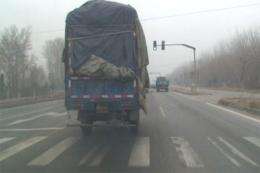Beijing polluted by heavy-emission truck, study says

The 62-mile, nine-day traffic jam in Beijing's August heat made international headlines -- and an epic amount of air pollution. It's the latest demonstration of how Cornell air quality researcher Max Zhang's work could make a critical difference for people who breathe bad air every day.
New research by Zhang, assistant professor of mechanical and aerospace engineering, targets diesel-fueled large trucks as the biggest culprits for polluting the air in and around Beijing. His latest study of the city's air quality, published online Sept. 21 in the journal Atmospheric Environment, particularly singles out a small number of the most severely polluting vehicles -- "heavy emitters" -- which contribute to a large share of total emissions.
Since 2007, Zhang has been working on quantifying air quality, using Beijing as his laboratory. His goal, he says, is to give governments and other organizations the data and tools necessary to combat the worsening air quality in major cities by accurately measuring it.
Zhang's tool of choice is a mobile laboratory -- a set of fast-response instruments that hang out of a minivan's window. For six straight days in 2009, he and his research team, which included graduate student Xing Wang and researcher Dane Westerdahl, literally chased vehicles while measuring the emissions in their wake, quantified into categories called emission factors.
Using a video camera, they also tracked routes and license plates. In total, they collected data on 230 trucks and 57 buses. Particularly, they looked at levels of carbon monoxide, black carbon (soot) and particulate matter with diameters of less than half a micron.
"We provided a very cost effective way to quantify emissions from large on-roads vehicles, complimentary to conventional laboratory emission testing," Zhang said.
Just 5 percent of all trucks surveyed were responsible for about half the total soot emissions among trucks and buses sampled. Those vehicles appeared overloaded and not well maintained. Surprisingly, the heaviest emitters they observed were rurally based three-wheeled diesel trucks that are largely unregulated by environmental standards.
"There are tens of millions of them, registered and unregistered, in China," Zhang said.
They also found, less surprisingly, that the vehicles registered in Beijing were less polluting, while vehicles from less-regulated areas tended to spew dirtier air.
In the coming year, Zhang will study more closely another class of key pollutants, nitrogen oxides, working with his Chinese collaborators to try and start changing policies around heavy-emitting trucks and buses by regulating or curbing them from the roads.
"We want to work with local air regulators to find ways to effectively reduce emission factors from the transportation sector," he said. "It's only the first step to identify the heavy emitters, but the real action is how to remove them."
Provided by Cornell University
















